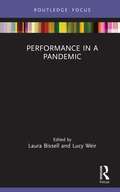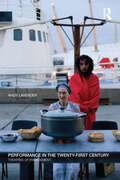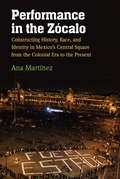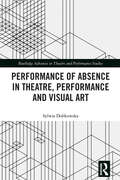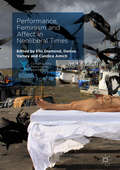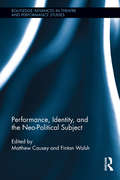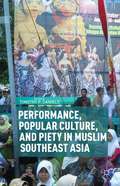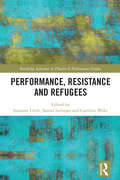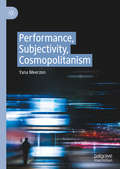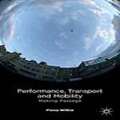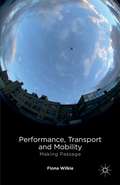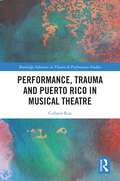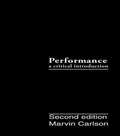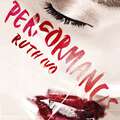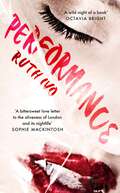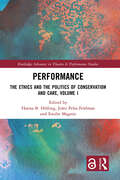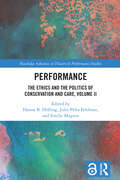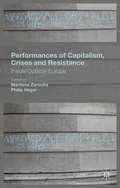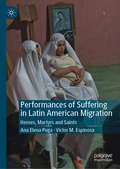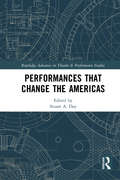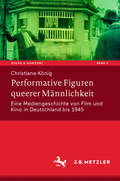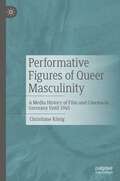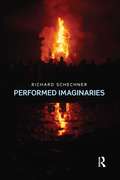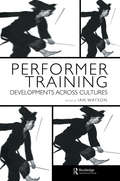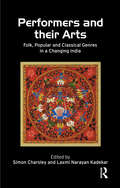- Table View
- List View
Performance in a Pandemic
by Laura BissellThis edited collection gathers UK and international artists, academics, practitioners, and researchers in the fields of contemporary performance, dance, and live art to offer creative-critical responses to the impact of the COVID-19 pandemic on their work. Themes addressed in these case studies include the ways in which liveness functions across digital platforms, the new demands on audiences and performance-makers, and the impact on international festivals as the digital removes geographical and locational restrictions. Brought together, these examples capture the creative activity and output that this unexpected cultural moment has provoked. Creative-critical responses interrogate what the global pandemic has taught us about what it is to make live work during lockdown and explore what the future of performance-making in a post-COVID world might look like. For all scholars and performance-makers whose work brings them into the sphere of contemporary art and culture, this is an essential and stimulating account of practice at the beginning of the 2020s.
Performance in the Twenty-First Century: Theatres of Engagement
by Andy LavenderPerformance in the Twenty-First Century: Theatres of Engagement addresses the reshaping of theatre and performance after postmodernism. Andy Lavender argues provocatively that after the ‘classic’ postmodern tropes of detachment, irony, and contingency, performance in the twenty-first century engages more overtly with meaning, politics and society. It involves a newly pronounced form of personal experience, often implicating the body and/or one’s sense of self. This volume examines a range of performance events, including work by both emergent and internationally significant companies and artists such as Rimini Protokoll, Blast Theory, dreamthinkspeak, Zecora Ura, Punchdrunk, Ontroerend Goed, Kris Verdonck, Dries Verhoeven, Rabih Mroué, Derren Brown and David Blaine. It also considers a wider range of cultural phenomena such as online social networking, sports events, installations, games-based work and theme parks, where principles of performance are in play. Performance in the Twenty-First Century is a compelling and provocative resource for anybody interested in discovering how performance theory can be applied to cutting-edge culture, and indeed the world around them.
Performance in the Zócalo: Constructing History, Race, and Identity in Mexico's Central Square from the Colonial Era to the Present
by Ana MartínezFor more than five centuries, the Plaza Mayor (or Zócalo) in Mexico City has been the site of performances for a public spectatorship. During the period of colonial rule, performances designed to ensure loyalty to the Spanish monarchy were staged there, but over time, these displays gave way to staged demonstrations of resistance. Today, the Zócalo is a site for both official government-sponsored celebrations and performances that challenge the state. Performance in the Zócalo examines the ways that this city square has achieved symbolic significance over the centuries, and how national, ethnic, and racial identity has been performed there. A saying in Mexico City is “quien domina el centro, domina el país” (whoever dominates the center, dominates the country) as the Zócalo continues to act as the performative embodiment of Mexican society. This book highlights how particular performances build upon each other by recycling past architectures and performative practices for new purposes. Ana Martínez discusses the singular role of collective memory in creating meaning through space and landmarks, providing a new perspective and further insight into the problem of Mexico’s relationship with its own past. Rather than merely describe the commemorations, she traces the relationship between space and the invention of a Mexican imaginary. She also explores how indigenous communities, Mexico’s alienated subalterns, performed as exploited objects, exotic characters, and subjects with agency. The book’s dual purposes are to examine the Zócalo as Mexico’s central site of performance and to unmask, without homogenizing, the official discourse regarding Mexico’s natives. This book will be of interest for students and scholars in theater studies, Mexican Studies, Cultural Geography, Latinx and Latin American Studies.
Performance of Absence in Theatre, Performance and Visual Art (Routledge Advances in Theatre & Performance Studies)
by Sylwia DobkowskaThis research project investigates the concepts of absence across the disciplines of visual art, theatre, and performance. Absence in the centre of an ideology frees the reader from the dominant meaning. The book encourages active engagement with theatre theory and performances. Reconsideration of theories and experiences changes the way we engage with performances, as well as social relations and traditions outside of theatre. Sylwia Dobkowska examines and theorises absence and presence through theatre, performance, and visual arts practices. This book will be of great interest to students and scholars of theatre, visual art and philosophy.
Performance, Feminism and Affect in Neoliberal Times (Contemporary Performance InterActions)
by Elin Diamond Denise Varney Candice AmichThis book is a provocative new study of global feminist activism that opposes neoliberal regimes across several sites including Asia, Australia, Canada, Europe, Latin America and the United States. The feminist performative acts featured in the book contest the aggressive unravelling of collectively won gains in gender, sexual and racial equality, the appearance of new planes of discrimination, and the social consequences of political economies based on free market ideology. The investigations of affect theory follow the circulation of intensities – of political impingements on bodies, subjective and symbolic violence, and the shock of dispossession – within and beyond individuals to the social and political sphere. Affect is a helpful matrix for discussing the volatile interactivity between performer and spectator, whether live or technologically mediated. Contending that there is no activism without affect, the collection brings back to the table the activist and hopeful potential of feminism.
Performance, Identity, and the Neo-Political Subject (Routledge Advances in Theatre & Performance Studies #28)
by Matthew Causey Fintan WalshThis book stages a timely discussion about the centrality of identity politics to theatre and performance studies. It acknowledges the important close relationship between the discourses and practices historically while maintaining that theatre and performance can enlighten ways of being with others that are not limited by conventional identitarian languages. The essays engage contemporary theatre and performance practices that pose challenging questions about identity, as well as subjectivity, relationality, and the politics of aesthetics, responding to neo-liberal constructions and exploitations of identity by seeking to discern, describe, or imagine a new political subject. Chapters by leading international scholars look to visual arts practice, digital culture, music, public events, experimental theatre, and performance to investigate questions about representation, metaphysics, and politics. The collections seeks to foreground shared, universalist connections that unite rather than divide, visiting metaphysical questions of being and becoming, and the possibilities of producing alternate realities and relationalities. The book asks what is at stake in thinking about a subject, a time, a place, and a performing arts practice that would come ‘after’ identity, and explores how theatre and performance pose and interrogate these questions.
Performance, Popular Culture, and Piety in Muslim Southeast Asia
by Timothy P. DanielsThe Muslim-majority nations of Malaysia and Indonesia are known for their extraordinary arts and Islamic revival movements. This collection provides an extensive view of dance, music, television series, and film in rural, urban, and mass-mediated contexts and how pious Islamic discourses are encoded and embodied in these public cultural forms.
Performance, Resistance and Refugees (Routledge Advances in Theatre & Performance Studies)
by Suzanne Little Samid Suliman Caroline WakeThis book offers a unique Australian perspective on the global crisis in refugee protection. Using performance as both an object and a lens, this volume explores the politics and aesthetics of migration control, border security and refugee resistance. The first half of the book, titled On Stage, examines performance objects such as verbatim and documentary plays, children’s theatre, immersive performance, slam poetry, video art and feature films. Specifically, it considers how refugees, and their artistic collaborators, assert their individuality, agency and authority as well as their resistance to cruel policies like offshore processing through performance. The second half of the book, titled Off Stage, employs performance as a lens to analyse the wider field of refugee politics, including the relationship between forced migrants and the forced displacement of First Nations peoples that underpins the settler-colonial state, philosophies of cosmopolitanism, the role of the canon in art history and the spectacle of bordering practices. In doing so, it illuminates the strategic performativity—and nonperformativity—of the law, philosophy, the state and the academy more broadly in the exclusion and control of refugees. Taken together, the chapters in this volume draw on, and contribute to, a wide range of disciplines including theatre and performance studies, cultural studies, border studies and forced migration studies, and will be of great interest to students and scholars in all four fields.
Performance, Subjectivity, Cosmopolitanism
by Yana MeerzonThis book looks at the connection between contemporary theatre practices and cosmopolitanism, a philosophical condition of social behaviour based on our responsibility, respect, and healthy curiosity to the other. Advocating for cosmopolitanism has become a necessity in a world defined by global wars, mass migration, and rise of nationalism. Using empathy, affect, and telling personal stories of displacement through embodied encounter between the actor and their audience, performance arts can serve as a training ground for this social behavior. In the centre of this encounter is a new cosmopolitan: a person of divided origins and cultural heritage, someone who speaks many languages and claims different countries as their place of belonging. The book examines how European and North American theatres stage this divided subjectivity: both from within, the way we tell stories about ourselves to others, and from without, through the stories the others tell about us.
Performance, Transport and Mobility
by Fiona WilkiePerformance, Transport and Mobility is an investigation into how performance moves, how it engages with ideas about movement, and how it potentially shapes our experiences of movement. In a world of apparently global flows of people, goods and ideas, what other stories of travel are told through performance? Using a critical framework drawn from the 'mobility turn' in the social sciences, Fiona Wilkie analyses a wide range of works from scripted plays to site-specific performances, from large-scale festivals to low-key private journeys, and from walking art to Motown music. Along the way, she examines discussions and documents of travel by foot, train, car, boat and plane to create a rich sense of historical and cultural context. In arguing for the capacity of theatre and art to make passage, Wilkie charts a compelling conversation about performance on the move and illuminates a set of practices that explore and challenge what it means to be in transit.
Performance, Transport and Mobility: Making Passage
by F. WilkiePerformance, Transport and Mobility is an investigation into how performance moves, how it engages with ideas about movement, and how it potentially shapes our experiences of movement. Using a critical framework drawn from the 'mobility turn' in the social sciences, it analyses a range of performances that explore what it means to be in transit.
Performance, Trauma and Puerto Rico in Musical Theatre (Routledge Advances in Theatre & Performance Studies)
by Colleen RuaThis study positions four musicals and their associated artists as mobilizers of defiant joy in relation to trauma and healing in Puerto Rico. The book argues that the historical trajectory of these musicals has formed a canon of works that have reiterated, resisted or transformed experiences of trauma through linguistic, ritual, and geographic interventions. These traumas may be disaster-related, migrant-related, colonial or patriarchal. Bilingualism and translation, ritual action, and geographic space engage moments of trauma (natural disaster, incarceration, death) and healing (community celebration, grieving, emancipation) in these works. The musicals considered are West Side Story (1957, 2009, 2019); The Capeman (1998); In the Heights (2008); and Hamilton (2015). Central to this argument is that each of the musicals discussed is tied to Puerto Rico, either through the representation of Puerto Rican characters and stories, or through the Puerto Rican positionality of its creators. The author moves beyond the musicals to consider Lin-Manuel Miranda as an embodied site of healing, that has been met with controversy, as well as posthurricane Maria relief efforts led by Miranda on the island and from a distance. In each of the works discussed, acts of belonging shape notions of survivorship and witness. This book also opens a dialogue between these musicals and the work of island-based artists Y no había luz, that has served as sites of first response to disaster. This book will be of interest to students and scholars in Latinx Theatre, Musical Theatre and Translation studies.
Performance: A Critical Introduction
by Marvin CarlsonThis comprehensively revised, illustrated edition discusses recent performance work and takes into consideration changes that have taken place since the book's original publication in 1996. Marvin Carlson guides the reader through the contested definition of performance as a theatrical activity and the myriad ways in which performance has been interpreted by ethnographers, anthropologists, linguists, and cultural theorists. Topics covered include: *the evolution of performance art since the 1960s *the relationship between performance, postmodernism, the politics of identity, and current cultural studies *the recent theoretical developments in the study of performance in the fields of anthropology, psychoanalysis, linguistics, and technology. With a fully updated bibliography and additional glossary of terms, students of performance studies, visual and performing arts or theatre history will welcome this new version of a classic text.
Performance: An electrifying memoir from the dark heart of London's Soho
by Ruth Ivo'Stunning . . . a love letter to the aliveness of London and its nightlife' SOPHIE MACKINTOSH'A wild night of a book' OCTAVIA BRIGHTAs 'Ruby', Ruth Ivo was a successful burlesque performer, living in blissful bohemian squalor on a decommissioned military boat and spending her evenings unfolding from a Fabergé egg in various London clubs. Her life changes when she is asked to become show director at 'The Club', a place as secretive as it is notorious. Before long, she's trawling Soho back streets for props and knocking back shots with movie stars and billionaires. But as her nights unravel in a maelstrom of glamour and chaos behind the scenes, she feels her grasp on reality slipping through her fingers, and her soul wrung out by decadence. Under pressure to produce shows each more shocking than the last, she watches the performers under her care contort themselves before baying crowds. When a devastating event leaves her unmoored, Ruby has to wonder if she's sold her soul to the devil . . . or become him. Performance is a visceral and exquisitely written portrait of a place that has come to embody the excesses of late capitalism; of tumbling willingly down the rabbit hole, only to lose yourself in the dark.______'Performance is theatrical, immersive and utterly heartbreaking. An astonishing debut' CHRISTIE WATSON'A story this addictive, it's hard not to consume it in one go' RHYANNON STYLES'I devoured this book in two days, all of its twisting corners and dark alleyways. I know Soho like the back of my hand and this brought that lost world back in vivid colours' JODIE HARSH
Performance: An electrifying memoir from the dark heart of London's Soho
by Ruth Ivo'Stunning . . . a love letter to the aliveness of London and its nightlife' SOPHIE MACKINTOSH'A wild night of a book' OCTAVIA BRIGHTAs 'Ruby', Ruth Ivo was a successful burlesque performer, living in blissful bohemian squalor on a decommissioned military boat and spending her evenings unfolding from a Fabergé egg in various London clubs. Her life changes when she is asked to become show director at 'The Club', a place as secretive as it is notorious. Before long, she's trawling Soho back streets for props and knocking back shots with movie stars and billionaires. But as her nights unravel in a maelstrom of glamour and chaos behind the scenes, she feels her grasp on reality slipping through her fingers, and her soul wrung out by decadence. Under pressure to produce shows each more shocking than the last, she watches the performers under her care contort themselves before baying crowds. When a devastating event leaves her unmoored, Ruby has to wonder if she's sold her soul to the devil . . . or become him. Performance is a visceral and exquisitely written portrait of a place that has come to embody the excesses of late capitalism; of tumbling willingly down the rabbit hole, only to lose yourself in the dark.______'Performance is theatrical, immersive and utterly heartbreaking. An astonishing debut' CHRISTIE WATSON'A story this addictive, it's hard not to consume it in one go' RHYANNON STYLES'I devoured this book in two days, all of its twisting corners and dark alleyways. I know Soho like the back of my hand and this brought that lost world back in vivid colours' JODIE HARSH
Performance: The Ethics and the Politics of Conservation and Care, Volume I (Routledge Advances in Theatre & Performance Studies)
by Hanna B. Hölling Jules Pelta Feldman Emilie MagninThis book focuses on performance and performance-based artworks as seenthrough the lens of conservation, which has long been overlooked in the largertheoretical debates about whether and how performance remains. Unraveling the complexities involved in the conservation of performance,Performance: The Ethics and the Politics of Conservation and Care (vol. 1)brings this new understanding to bear in examining performance as an object ofstudy, experience, acquisition, and care. In so doing, it presents both theoreticalframeworks and functional paradigms for thinking about—and enacting—theconservation of performance. Further, while the conservation of performance isundertheorized, performance is nevertheless increasingly entering the artmarket and the museum, meaning that there is an urgent need for discourse onhow to care for these works long-term. In recent years, a few pioneering conservators,curators, and scholars have begun to create frameworks for the longtermcare of performance. This volume presents, explicates, and contextualizestheir work so that a larger discourse can commence. It will thus serve the needsof conservation students and professors, for whom literature on this subject issorely needed. This interdisciplinary book thus implements a novel rethinking of performancethat will challenge and revitalize its conception in many fields, such as art history,theater, performance studies, heritage studies, and anthropology.
Performance: The Ethics and the Politics of Conservation and Care, Volume II (Routledge Advances in Theatre & Performance Studies)
by Hanna B. Hölling Jules Pelta Feldman Emilie MagninRepresenting the output of the research project "Performance: Conservation, Materiality, Knowledge," this volume brings together diverse voices, methods, and formats in the discussion and practice of performance conservation.Conservators, artists, curators and scholars explore the ontology of performance art through its creation and institutionalization into an astonishing range of methods and approaches for keeping performance alive and well, whether inside museum collections or through folk traditions. Anchored in the disciplines of contemporary art conservation, art history, and performance studies, the contributions range far beyond these to include perspectives from anthropology, musicology, dance, law, heritage studies, and other fields. While its focus is on performance as understood in the context of contemporary art, the book’s notion of performance is much wider, including other media such as music, theater, and dance as well as an open-ended concept of performance as a vital force across culture(s).While providing cutting-edge research on an emerging and important topic, this volume remains accessible to all interested readers, allowing it to serve as a singularly valuable resource for museum professionals, scholars, students, and practitioners.
Performances of Capitalism, Crises and Resistance
by Marilena Zaroulia Philip HagerThis engaging study examines the issue of crisis in European performance since the collapse of global financial markets in 2008. The book's chapters examine diverse performances of crisis primarily in three cities with a loaded past and present for Europe, as idea and geopolitical reality: London, Athens and Berlin. Presenting a range of work – from the National Theatre's repertoire to alternative forms of theatre-making in 'other' spaces; from the Occupy LSX to cultural performance and 'invisible', quotidian performances – Performances of Capitalism, Crises and Resistance presents new approaches to performance as a form 'in crisis' and as reflecting the in-crisis permutation of the 'inside/outside' dichotomy, fundamental in the conception of Europe and the EU. In doing so, this book makes an argument for performance within and against neoliberal promises; as a monolithic factor implicated in the machinery of capitalism or multiple, emergent bodies of resistance.
Performances of Suffering in Latin American Migration: Heroes, Martyrs and Saints
by Ana Elena Puga Víctor M. EspinosaThis book questions the reliance on melodrama and spectacle in social performances and cultural productions by and about migrants from Mexico and Central America to the United States. Focusing on archetypal characters with nineteenth-century roots that recur in the twentieth- and twenty-first centuries – heroic saviors, saintly mothers and struggling fathers, martyred children and rebellious youth – it shows how theater practitioners, filmmakers, visual artists, advocates, activists, journalists, and others who want to help migrants often create migrant melodramas, performances that depict their heroes as virtuous victims at the mercy of evil villains. In order to gain respect for the human rights that are supposedly already theirs on paper and participate in a global market that trades in performances of suffering, migrants themselves sometimes accept the roles into which they are cast, or even cast themselves. Some express their suffering publicly, often on demand. Others find ways to twist, parody, resist, or reject migrant melodrama.
Performances that Change the Americas (Routledge Advances in Theatre & Performance Studies)
by Stuart A. DayThis collection of essays explores activist performances, all connected to theater or performance training, that have changed the Americas—from Canada to the Southern Cone. Through the study of specific examples from numerous countries, the authors of this volume demonstrate a crucial, shared outlook: they affirm that ordinary people change the direction of history through performance. This project offers concrete, compelling cases that emulate the modus operandi of people like historian Howard Zinn. In the same spirit, the chapters treat marginal groups whose stories underscore the potentially unstoppable and transformative power of united, embodied voices. This book will be of great interest to students and scholars of theatre, performance, art and politics.
Performative Figuren queerer Männlichkeit: Eine Mediengeschichte von Film und Kino in Deutschland bis 1945 (Szene & Horizont. Theaterwissenschaftliche Studien #5)
by Christiane KönigDie medienkulturgeschichtliche Arbeit ist eine deutsche Kino- und Filmgeschichte von den 1890er Jahren bis 1945 mit Fokus auf queere Männlichkeit. Mit medienwissenschaftlichen Ansätzen zeigt die Studie, wie sich das ‚neue Medium’ Film durch performative Wiederaufführungen spektakulärer Elemente aus den Unterhaltungs- und Wissenskulturen des 19. Jahrhunderts konstituiert. Darin werden Körper, Begehren und Identitäten durch Differenzbildungen ständig remodelliert. Männliche Queerness bedeutet hier folglich nicht Repräsentation männlicher Homosexualität. Vielmehr ist sie dynamisches Ergebnis komplexer medialer Prozesse, in Verknüpfung mit Affekten und (Selbst-)Erkenntnissen auf und vor der Leinwand. Aufbauend auf dem queer-feministischen Konzept der queer performativity von Eve K. Sedgwick, erstellt die Autorin ein historisch situiertes Modell, mit dem sie verschiedene Figuren technisch-anthropomorpher queerer Männlichkeit des Mediums Film im ermächtigenden Sinne nachzeichnet. Die anhand von einzelnen Langfilmen herauspräparierten Figuren sind dabei stets mitbedingt durch Veränderungen der assemblage des Kino-Apparats über die Jahrzehnte bis 1945 sowie durch zeitgenössisch aktuelle Aspekte der Geschlechtergeschichte und der Geschichte der Sexualität in Deutschland.
Performative Figures of Queer Masculinity: A Media History of Film and Cinema in Germany Until 1945
by Christiane KönigThis is a German history of cinema and film from the 1890s to 1945 with a focus on queer masculinity. Using media studies approaches, the study shows how film as a new medium is constituted through performative re-enactments of spectacular elements from the entertainment and knowledge cultures of the 19th century. In it, bodies, desires and identities are constantly remodelled through the formation of difference. Therefore, male queerness here does not mean the representation of male homosexuality. Rather, it is the dynamic result of complex medial processes, affects and (self-)knowledge on and off the screen. Building on Eve K. Sedgwick's queer-feminist concept of queer performativity, the author creates a historically situated model with which she traces various figures of technically anthropomorphic queer masculinity in the medium of film in an empowering sense. This book is a translation of an original German 1st edition Performative Figuren queerer Männlichkeit by Christiane König, published by J.B.Metzler, imprint of Springer-Verlag GmbH Germany, part of Springer Nature in 2020. The translation was done with the help of artificial intelligence (machine translation by the service DeepL.com). The author (with the friendly support of Megan Hanson) has subsequently revised the text further in an endeavour to refine the work stylistically. Springer Nature works continuously to further the development of tools for the production of books and on the related technologies to support authors.
Performed Imaginaries
by Richard SchechnerIn this collection of essays, performance studies scholar and artist Richard Schechner brings his unique perspective to bear upon some of the key themes of society in the 21st century. Schechner connects the avantgarde and terror, the counter-cultural movement of the 1960s/70s and the Occupy movement; self-wounding art, popular culture, and ritual; the Ramlila cycle play of India and the way imagination structures reality; the corporate world and conservative artists. Schechner asks artists to redeploy Nehru's Third World as a movement not of nations but of like-minded culture workers who must propose counter-performances to war, violence, and the globalized corporate empire. With characteristic brio, Schechner urges us to play for keeps. "Playing deeply is a way of finding and embodying new knowledge", he writes. Performed Imaginaries ranges through some of the key moves within Schechner’s oeuvre, and challenges today’s experimental artists, activists, and scholars to generate a new, third world of performance.
Performer Training: Developments Across Cultures (Contemporary Theatre Studies #Vol. 38)
by Ian WatsonPerformer Training is an examination of how actors are trained in different cultures. Beginning with studies of mainstream training in countries such as Poland, Australia, Germany, and the United States, subsequent studies survey: · Some of Asia's traditional training methods and recent experiments in performer training · Eugenio Barba's training methods · Jerzy Grotowski's most recent investigations · The Japanese American NOHO companies attempts at integrating Kyogen into the works of Samuel Beckett · Descriptions of the training methods developed by Tadashi Suzuki and Anne Bogart at their Saratoga International Theatre Institute · Recent efforts to re-examine the role and scope of training, like Britain's International Workshop Festival and the European League of Institutes of Arts masterclasses · The reformulation of the use of emotions in performer training known as Alba Emoting.
Performers and Their Arts: Folk, Popular and Classical Genres in a Changing India
by Simon CharsleyIntroduction Part I: Caste, Community and performance A ritual performance of Kerala, Vayala Vasudevan PillaiThe Patuas of Bengal, Makbul IslamBards and goddesses: The Pombalas in Tirupati, Anand AkundyExplorations in the art forms of the Cindu madigas in Andhra, Y A Sudhakar Reddy and R R HarischandraCaste identity and performance in a fisher-village of Assam, Kishore BhattacharjeePart II: Performance Beyond CasteTelugu pady natakam in Andhra: Performance dynamics, P SubbacharyModernising tradition: The yaksagana in Karnataka, Guru Rao BapatKalarippayatt as aesthetics and the politics of invisibility in Kerala, P K SasidharanIndia People’s Theatre Association in colonial Andhra, V RamakrishnaGaddar and the politics and pain of singing, D Venkat RaoReviving moghal tamsa in Orissa, Sachi MohantyPart III: Classical Dance and its SuccessorsNew directions in Indian dance, Sunil KothariTranspositions in kuchipudi dance, Aruna BhikshuThe impact of commercialization in dance, K Subadra MurthyArt addressing social problems, Ananda Shankar Jayant
